Section 21
Alphabetic References
21.1 Fundamentals
21.2 General Format for Alphabetic References
21.3 Guide Words
21.4 Indexes
21.5 References without Syllabification or Pronunciation
21.6 Glossaries
21.7 Thesauruses
21.8 Dictionaries and Facsimiles
21.9 Alphabetic References in Foreign Language Materials
21.10 Samples
21.1 Fundamentals
Bibliographies fall into a separate category and are an exception to the guidelines in this section. (See Formats, §22, Bibliographies.)
21.2 General Format for Alphabetic References
a. Start each alphabetic reference on a new braille page.
b. The main entry begins in cell 1. Each subentry level begins two cells to the right of the previous level. All runovers begin two cells to the right of the farthest indented subentry.
One level: 1-3
Two levels: 1-5, 3-5
Three levels: 1-7, 3-7, 5-7
Four levels: 1-9, 3-9, 5-9, 7-9 etc.
Example 21-1: Italicized Entry Word

8,ac;n >*aeology10 #cjb
,ac;n !ory ( develop;t ( /ates1 #cac1
⠀⠀#caf
.1,adapis1 #acj
,adapta;n1 #ej1 #eb1 #ee
a. Center alphabetical division letters.
b. The grade 1 indicator is used before alphabetical division letters as required.
c. Insert a blank line before, but not after, the first alphabetical division.
d. Do not insert blank lines before or after other alphabetical divisions.
e. Follow print for capitalization.
f. Alphabetical divisions are followed by at least one line of text at the bottom of the braille page.
Example 21-2: Alphabetical Division Preceded by a Blank Line

⠀⠀⠀⠀⠀⠀⠀,^ws to ,"k3 ,a3ess ,guide
⠀⠀⠀⠀⠀⠀⠀⠀⠀⠀⠀⠀⠀⠀⠀⠀⠀⠀⠀⠀⠀⠀⠀⠀⠀⠀⠀⠀⠀⠀⠀⠀⠀⠀⠀⠀⠀⠀⠀⠀
,g to ! page numb] = ^w def9i;ns4
⠀⠀⠀⠀⠀⠀⠀⠀⠀⠀⠀⠀⠀⠀⠀⠀⠀⠀⠀⠀⠀⠀⠀⠀⠀⠀⠀⠀⠀⠀⠀⠀⠀⠀⠀⠀⠀⠀⠀⠀
⠀⠀⠀⠀⠀⠀⠀⠀⠀⠀⠀⠀⠀⠀⠀⠀⠀⠀⠀,a
abom9ably1 #icj
g. Insert one blank line when print uses only blank lines to separate alphabetical divisions.
Example 21-3: Blank Lines Indicating Alphabetical Divisions

,ext]nal migra;n1 #gjg
,ext9c;n1 #fhc-#fhd
⠀⠀⠀⠀⠀⠀⠀⠀⠀⠀⠀⠀⠀⠀⠀⠀⠀⠀⠀⠀⠀⠀⠀⠀⠀⠀⠀⠀⠀⠀⠀⠀⠀⠀⠀⠀⠀⠀⠀⠀
,falcip>um mal>ia1 #c1 #dd1 #ec1 #ed
h. Do not insert blank lines if alphabetical divisions are not indicated in print.
Example 21-4: Alphabetical Divisions not Indicated

,ext]nal migra;n1 #gjg
,ext9c;n1 #fhc-#fhd
,falcip>um mal>ia1 #c1 #dd1 #ec1 #ed
a. Follow print for placement.
b. Retain font attributes.
Example 21-5: Cross-References

,hi< ,middle ,ages1 #bag-#db
⠀⠀,agriculture1 #bah-#bj1 #bbi
⠀⠀,russia1 #bed-#ee4 .1,see .1al ,soviet
⠀⠀⠀⠀,union
⠀⠀.1,see .1al ,e>ly ,middle ,ages
a. Include the type of alphabetic reference, e.g., "Index," "Thesaurus," etc.
b. Use uncontracted braille for the letter sequences.
c. Place the same letter sequence on the volume binding or spine in both print and braille.
Example 21-6: Title Page Format for Inclusive Letters of Index
,volume #b ,9dex ;alt-arte
a. Omit print guide words unless the text is teaching readers how to use guide words.
b. When discussed in the text, center the print page guide words at the beginning of each print page.
c. Do not leave blank lines before or after print page guide words.
d. Insert a transcriber's note before an excerpt or facsimile to inform the reader when print shows only the first and last entry words on facing pages. Sample:
In the excerpt below, print guide words are centered at the beginning of each print page.
Example 21-7: Print Guide Words on Facing Pages
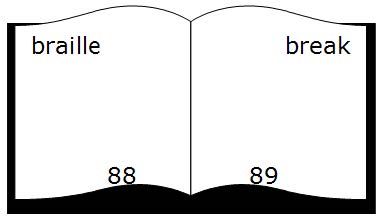
⠀⠀⠀⠀⠀⠀⠀⠀⠀⠀⠀⠀⠀⠀⠀⠀⠀⠀brl #hh
text 444
-------------------------------------#hi
⠀⠀⠀⠀⠀⠀⠀⠀⠀⠀⠀⠀⠀⠀⠀⠀⠀⠀br1k
text 444
e. Follow print for the symbol used between two guide words.
Example 21-8: Examples of Print Guide-Word Separators

1 ⠀⠀⠀⠀⠀⠀⠀⠀⠀⠀⠀⠀⠀⠀⠀9f],-9h]it #cca
1 ⠀⠀⠀⠀⠀⠀⠀⠀⠀⠀⠀⠀⠀⠀⠀9f]_49h]it #cca
1 ⠀⠀⠀⠀⠀⠀⠀⠀⠀⠀⠀⠀⠀⠀9f];\o9h]it #cca
1 ⠀⠀⠀⠀⠀⠀⠀⠀⠀⠀⠀⠀⠀⠀⠀9f] _\ 9h]it #cca
a. Guide words indicate the first and last main entries on the braille page.
b. Do not generate guide words for subentries.
c. Center guide words on the last line of every braille page.
d. At least three blank cells must precede the first guide word.
e. Leave at least three blank cells between the last guide word and braille page number.
f. Leave at least three blank cells after the second guide word when there is no braille page number on interpoint even pages.
g. Do not include punctuation attached to the end of the entry word in the guide word text.
h. Use a dash to connect guide words.
Example 21-9: Guide Words with Dash

25 ⠀⠀⠀⠀⠀⠀⠀⠀⠀⠀⠀aborig9al,--agogy #,-
i. Shorten guide words when entry words are too long to fit. Do not add a period. Include enough letters from each entry word to make it intelligible.
Example 21-10: Shortened Guide Words

25 ⠀⠀⠀⠀⠀acetylsal,-acquir$ immune def⠀⠀⠀#,-
j. Use the last guide word from the previous page(s) followed by "(cont.)" when there are no new main entry words on a braille page.
Example 21-11: Continued Guide Word
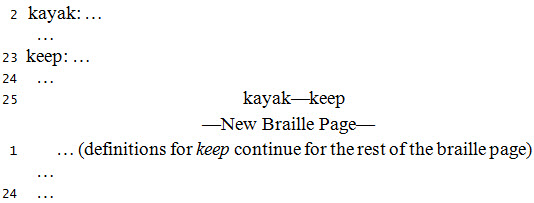
25 ⠀⠀⠀⠀⠀⠀⠀⠀⠀⠀⠀⠀⠀⠀keep "<3t4"> #,-
21.4 Indexes
Example 21-12: Emphasized Page Numbers

⠀⠀⠀⠀⠀⠀⠀⠀⠀⠀⠀⠀⠀⠀⠀⠀⠀,9dex⠀⠀⠀⠀⠀⠀⠀⠀⠀⠀⠀⠀⠀⠀#icb
⠀⠀⠀⠀⠀⠀⠀⠀⠀⠀⠀⠀⠀⠀⠀⠀⠀⠀⠀⠀⠀⠀⠀⠀⠀⠀⠀⠀⠀⠀⠀⠀⠀⠀⠀⠀⠀⠀⠀⠀
⠀⠀,page numb]s af an ;m ref] to a map4
⠀⠀⠀⠀⠀⠀⠀⠀⠀⠀⠀⠀⠀⠀⠀⠀⠀⠀⠀⠀⠀⠀⠀⠀⠀⠀⠀⠀⠀⠀⠀⠀⠀⠀⠀⠀⠀⠀⠀⠀
⠀⠀⠀⠀⠀⠀⠀⠀⠀⠀⠀⠀⠀⠀⠀⠀⠀⠀⠀,a
,aeg1n ,sea1 #bdg1 #bdh1 #bej1 m#bdg
,africa1 #cfh-#cgc1 #fga1 m#fjh
Example 21-13: Index with Listed Subentry

⠀⠀⠀⠀⠀⠀⠀⠀⠀⠀⠀⠀⠀⠀⠀⠀⠀⠀⠀,a
,ab5aki1 cr1;n my?s (1 #feh-#fei
,acquir$ immune defici5cy syndrome
⠀⠀⠀⠀"<,,aids">
⠀⠀culturally specific $uca;n & s]vices
⠀⠀⠀⠀=1 #dij-#dia
,ac;n an?ropology1 #fhg
Example 21-14: Paragraphed Index Entries with Subentries

,air,ways1 #gj
,alabama1
⠀⠀z "r-to-"w law /ate1 #bja2
⠀⠀p] capita p]sonal 9come1 #cii2
⠀⠀gr[? ( r1l p] capita p]sonal 9come1
⠀⠀⠀⠀#cii
21.5 References without Syllabification or Pronunciation
a. The entry-word segment includes the word or phrase being defined.
b. The definition segment includes the part-of-speech label, definition, descriptions, examples, etc.
c. Leave one blank cell between the entry-word segment and the definition segment when the entry word is followed by punctuation, capitalization, or enclosure symbols.
Example 21-15: Entry Word Followed by Punctuation
addic;n3⠀compulsive drug crav+ & use1
⠀⠀despite adv]se 3sequ;es
Example 21-16: Entry Word Followed by Capitalization
alpha⠀waves⠀,! relatively sl[ bra9 waves
⠀⠀( a relax$1 awake /ate4
Example 21-17: Entry Word Followed by Enclosure Symbols
antique⠀"<;n4"> relic1 >tifact1
⠀⠀heirloom1 survival1 r>;y1 monu;t1
⠀⠀ve/ige1 ru94
d. Leave two blank cells between the entry-word segment and the definition segment when it is not followed by punctuation, capitalization, or enclosure symbols.
Example 21-18: Entry Word Followed by Lowercase Definition
acronym⠀⠀a ^w =m$ by us+ ! 9itial lrs (
⠀⠀o!r ^ws3 rad> "<.1ra.'dio .2detect+
⠀⠀.2& .2rang+">
e. Insert two blank spaces before the start of all definitions or descriptions when the alphabetic reference has a variety of entry styles.
Example 21-19: Mixed Entries
daft⠀⠀crazy1 silly
daily⠀"<dailies">⠀⠀o3urr+ e "d
a. Omit font attributes unless needed for distinction.
b. Follow print for use of punctuation.
Example 21-20: Abbreviation with Font Attribute Omitted
apply⠀⠀;v to lay or spr1d on4
Example 21-21: Sample Sentence with Font Attributes
apply⠀⠀to lay or spr1d on4 .7,pl1se
⠀⠀^1apply ! wax 9 a circul> mo;n4.'
21.6 Glossaries
a. Use contracted braille for English entry words.
b. Use uncontracted braille for foreign language entry words, using the appropriate accented letters and symbols for the language. (See UEB, §13, Foreign Language.)
c. List foreign language symbols on the Special Symbols page.
Example 21-22: Simple English/Spanish Glossary

bact]ia_/bacter/as⠀,peque]/simos
⠀⠀microorganismos unicelulares4
⠀⠀"<,b#ei">
bal.e_/equilibrio⠀,la habilidad de no
⠀⠀caer4 "<,c#be">
2nign_/benigno⠀,que no es canceroso4
⠀⠀"<,d#fd">
d. The language by which the glossary is organized should be used for guide words. (See Sample 21-4: Guide Words for English/Spanish Glossary on page 21-32.)
e. English and foreign language glossary words may appear as separate entries on the same page. Use 1-5 margins for the main entry words, 3-5 margins for the subentry words. (See Sample 21-5: Side-by-Side English/Spanish Glossary on page 21-33 and Sample 21-6: Nested English/Spanish Glossary on page 21-34.)
f. English and foreign language glossary word entries may appear on facing pages. Combine the entries into a nested list as above, and use combined print page numbers, e.g., 454-455, a454-455, b454-455, etc.
a. Omit illustrations when they do not add information to the entry.
b. Retain diagrams in math and science textbooks.
c. Treat the entry word or entry heading as a cell-5 heading. Use this format for the entire section, even if some entries do not have samples.
d. Guide words are generated from the cell-5 headings.
e. Use the appropriate format for the example, e.g., paragraphs, poetry, etc.
f. Do not insert a blank line between the heading and illustrative material, even though blank lines are required in specific formats, such as poetry. (See Sample 21-7: Glossary with Lines of Poetry on page 21-35.)
g. Examples of glossary terms are treated as displayed material when they follow the definition. (See Formats, §9, Displayed Material, Attributions, and Source Information.)
(See Sample 21-8: Glossary with Displayed Text on page 21-36.)
21.7 Thesauruses
a. Follow print layout of entries and subentries.
b. Follow print for the spacing of a dash, which typically indicates antonyms. This dash cannot end a braille line.
a. Use a nested list format, with 1-5 margins for all main entries and 3-5 margins for all subentries.
b. Omit font attributes for entry words at the main and subentry levels.
(See Sample 21-10: Multilevel Thesaurus on page 21-39.)
21.8 Dictionaries and Facsimiles
Example 21-23: Dictionary Entry with Left Angle Bracket

b\lev>d b\_4le_4v>d
⠀⠀"<bo^6ol^.b_5 v^3ard^.2">⠀;n4 .<;,fr
⠀⠀@< ,m,du .1bolw]c1 bulw>k.> a broad
⠀⠀/reet l9$ ) trees1 etc4
a. Symbolic Colon. Some dictionaries use the symbolic colon (i.e., a boldface or regular colon, often printed with a space preceding and following it) to introduce a definition, or to separate two or more definitions. Follow print for placement and emphasis.
Example 21-24: Lightface Symbolic Colon
uncage⠀444⠀.1transitive .1v]b 3 to
⠀⠀rel1se f or z if f a cage 3 free f
⠀⠀re/ra9t
b. Dashes and Swung Dashes. Many dictionaries use the dash and/or the swung dash to replace or stand for the main entry word at certain points in the entries. Follow print for emphasis, number, and spacing of dashes.
Example 21-25: Angle Brackets, Swung Dash
/ay 444
⠀⠀#f4 to keep ev5 9 a 3te/ or rivalry
⠀⠀⠀⠀@<^2@9 ) ! l1d]s@>
c. Follow print when a swung dash is followed by an unspaced letter or letters.
Example 21-26: Symbolic Colon, Angle Brackets, Swung Dash
/ay 444
⠀⠀#c4 ^23 to rema9 dur+ @<^2@9$ ! :ole
⠀⠀⠀⠀"t@>
a. Entry. The entry includes the word or phrase being defined. It also includes pronunciation information; derivations; parts of speech; definitions; subentries, antonyms, synonyms; sample sentences; and illustrations.
Example 21-27: Entry (See Example 21-30 for Braille)

b. Entry-Word Segment. A main entry-word segment includes the word or phrase, the respelling, and the pronunciation.
Example 21-28: Entry-Word Segment in Dictionary Entry (Print Only)

c. Definition Segment. The definition segment includes the part-of-speech label, definition, descriptions, examples, etc.
Example 21-29: Definition Segment in Dictionary Entry (Print Only)

d. Subentry. A subentry is an entry that is subservient to the main entry. It may be a definition, another part of speech, another form of spelling, or a cross-reference.
Example 21-30: Subentry in Dictionary Entry

pres5ta;n pre-s5-ta-tion
⠀⠀⠀⠀⠀⠀_*pre^.2-z5-t@-a^.b-%_5n_*
⠀⠀;n "<#ae ;c">
⠀⠀#a
⠀⠀⠀⠀a 3 ! act ( pres5t+
⠀⠀⠀⠀;b 3 ! act1 p[]1 or privilege esp4 (
⠀⠀⠀⠀⠀⠀a patron ( apply+ to ! bi%op or
⠀⠀⠀⠀⠀⠀ord9>y = 9/itut+ "s"o 9to a
⠀⠀⠀⠀⠀⠀b5efice
⠀⠀#b 3 "s?+ pres5t$3
⠀⠀⠀⠀a 3 a symbol or image t repres5ts
⠀⠀⠀⠀⠀⠀"s?+
⠀⠀⠀⠀;b 3 "s?+ (f]$ or giv5
⠀⠀#c 3 an imm object ( p]cep;n1 cogni;n1
⠀⠀⠀⠀⠀⠀or memory
⠀⠀,-pres5ta;nal pre-s5-ta-tion-;al
e. Sub-subentry. A sub-subentry is subservient to the subentry.
Example 21-31: Sub-subentry in Dictionary Entry (Print Only)

Example 21-32: Single-Level Dictionary Entries
active duty,-,full-"t duty 9 ! active
⠀⠀milit>y s]vice ( ! ,unit$ ,/ates4 ,see
⠀⠀al ^7active duty = tra9+2 9active duty
⠀⠀tra9+4^'
a. Parts of speech: Each part of speech is treated as a subentry when an entry includes more than one part-of-speech label.
b. Each numbered or lettered definition.
c. Run-in derived entries, e.g., —flat-ly adv. —flat-ness n.
d. Synonyms or antonyms.
e. "See also" references when they apply to the entry and all subentries.
Example 21-33: Dictionary with Subentries

improve im-prove "<im_4pr@-<o^6o>v^.b">
⠀⠀⠀⠀;v4
⠀⠀#a to make or 2come bett] .<,busi;s
⠀⠀⠀⠀has .1improv$4.>
⠀⠀#b to make gd use ( .<,%e .1improv$ h]
⠀⠀⠀⠀sp>e "t by r1d+4.>
⠀⠀,-^7improv$ im_4prov$^.b1 improv+
⠀⠀⠀⠀im_4prov^.b9g^'
f. Second-definition levels are treated as sub-subentries.
g. Words of foreign derivation are contracted.
(See Sample 21-11: Dictionary with Sub- and Sub-subentries on page 21-40.)a. Regardless of print placement, place the superscript number after the entry word in braille. Follow print for spacing.
b. List the superscript indicator on the Special Symbols page, or in a transcriber's note before the text.
c. Insert a transcriber's note when the superscript numbers appear before the entry words in print. Sample:
Superscript numbers appear before the entry word in print. They are inserted after the entry word in braille. .=9 is the superscript indicator.
Example 21-34: Superscript Numbers Before Entry Words
live;9#a _/l@+iv_/⠀;v4 9tr4 ,to 2 alive2
⠀⠀exi/
live;9#b _/l@-iv_/⠀adj4 ,hav+ life2
⠀⠀alive3 live animals
Example 21-35: Superscript Numbers After Entry Words
live;9#a _/l@+iv_/⠀;v4 9tr4 ,to 2 alive2
⠀⠀exi/
live;9#b _/l@-iv_/⠀adj4 ,hav+ life2
⠀⠀alive3 live animals
21.9 Alphabetic References in Foreign Language Materials
a. Ignore print emphasis for entry words, subentry words, and all translations and definitions unless needed for distinction.
b. It is important to determine whether abbreviations are given in English or in the foreign language, e.g., inf. can mean either infinitive or infinitif, and sing. may represent either singular or singulier. Follow the guidelines for foreign language materials using contracted braille for English abbreviations and uncontracted braille for foreign abbreviations. (See Formats, §1.16, Foreign Material in English Context.)
a. Use nested list format.
b. A complete entry word consists of the main entry word itself plus its pronunciation, abbreviation for gender, part of speech, and other forms of the word.
c. Insert a braille colon to indicate a change in language after each complete entry or subentry word that is followed by a translation. If a print comma appears at this point, omit it and substitute a colon.
d. If a special print sign (e.g., an asterisk) is printed after an entry word, the asterisk symbol is transposed to precede the entry word. Explain this rearrangement in a transcriber's note placed before its first occurrence.
e. Use the following format when articles, reflexive pronouns, special print signs, specially marked items, or English infinitives, are shown before entry words.
(1) Begin the longest article, reflexive pronoun, etc. in cell 1.
(2) Align the initial letters of the foreign language words.
(3) The left margin is the braille cell in which the initial letter of the entry words appears.
(4) Adjust each braille page to align the main entry words on that page.
(5) All runovers are two cells to the right of the main entry left margin. If the main entry begins in cell 4, runovers are in cell 6; if the main entry begins in cell 5, runovers are in cell 7.
(6) Begin subentries two cells to the right of the main entry margin and adjust the runovers accordingly. If the main entry begins in cell 5, all subentries begin in cell 7 and all runovers begin in cell 9.
(7) When there is more than one element preceding a foreign main entry word, the established margin is still at the entry word itself.
Example 21-36: Foreign Language Glossary
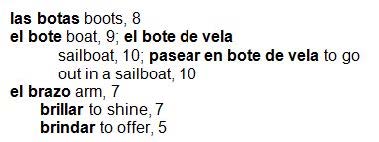
las botas3 boots1 #h
⠀el bote3 boat1 #i2
⠀⠀⠀⠀⠀⠀el bote de vela3 sailboat1 #aj2
⠀⠀⠀⠀⠀⠀pasear en bote de vela3 to g \ 9 a
⠀⠀⠀⠀⠀⠀⠀⠀sailboat1 #aj
⠀el brazo3 >m1 #g
⠀⠀⠀⠀brillar3 to %9e1 #g
⠀⠀⠀⠀brindar3 to (f]1 #e
f. When a print colon and a subentry word, rather than a translation, are shown following the entry word, substitute a semicolon for the colon. Place the subentry word on the following braille line at the established margin. The translation follows on the next braille line indented two cells to the right of the established margin.
Example 21-37: Foreign Language Glossary with Print Colon
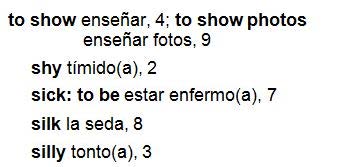
to %[3 ense]ar1 #d2
⠀⠀⠀⠀⠀to %[ photos3 ense]ar fotos1 #i
⠀⠀⠀%y3 t/mido"<a">1 #b
⠀⠀⠀sick2 to be3 estar enfermo"<a">1 #g
⠀⠀⠀silk3 la seda1 #h
⠀⠀⠀silly3 tonto"<a">1 #c
a. Insert the appropriate modifier (unspaced) before the braille dash or hyphen if an accent mark is shown above the print symbol. (See UEB, §4.2, Modifiers.) Explain this usage on the Special Symbols page.
b. Represent a spaced dash, hyphen, or special print sign that is used to indicate the repetition of an entire word by a spaced braille dash.
Example 21-38: Repetitions Shown with Print Symbols

coup1 ,- de pied
der ,laden1 ^3,-
das ,leben1 ,-
c. Represent a dash, hyphen, or special print sign (often unspaced) used to indicate the omission of a word or word part to which an addition is to be made by the braille hyphen.
Example 21-39: Additions Represented by Print Symbols
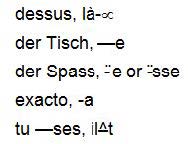
dessus1 l(--
der ,tisch1 -e
der ,spass1 ^3-e or ^3-sse
exacto1 -a
tu -ses1 il^%-t
a. Omit articles, reflexive pronouns, or other elements that precede foreign entry words when choosing guide-word text.
b. Use only the initial entry word as a guide word when an entry consists of two or more foreign words. Use the first two words of an entry when two or more consecutive entries have the same initial word.
21.10 Samples
Sample 21-2: Multilevel Glossary, page 21-28
Sample 21-3: Glossary with Diacritics, page 21-30
Sample 21-4: Guide Words for English/Spanish Glossary, page 21-32
Sample 21-5: Side-by-Side English/Spanish Glossary, page 21-33
Sample 21-6: Nested English/Spanish Glossary, page 21-34
Sample 21-7: Glossary with Lines of Poetry, page 21-35
Sample 21-8: Glossary with Displayed Text, page 21-36
Sample 21-9: Single-Level Thesaurus, page 21-38
Sample 21-10: Multilevel Thesaurus, page 21-39
Sample 21-11: Dictionary with Sub- and Sub-subentries, page 21-40
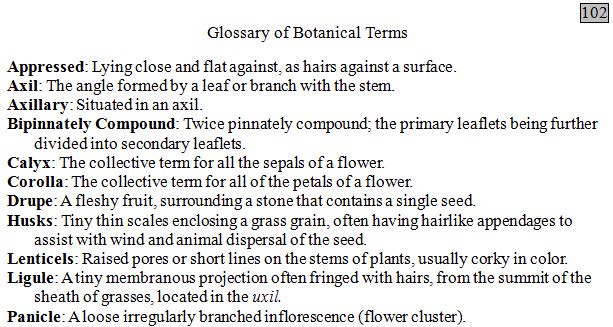
1⠀⠀⠀⠀⠀⠀⠀,gloss>y ( ,botanical ,t]ms #ajb
2⠀⠀⠀⠀⠀⠀⠀⠀⠀⠀⠀⠀⠀⠀⠀⠀⠀⠀⠀⠀⠀⠀⠀⠀⠀⠀⠀⠀⠀⠀⠀⠀⠀⠀⠀⠀⠀⠀⠀⠀⠀
3⠀,appress$3 ,ly+ close & flat ag/1 z
4⠀⠀⠀hairs ag/ a surface4
5⠀,axil3 ,! angle =m$ by a l1f or bran* )
6⠀⠀⠀! /em4
7⠀,axill>y3 ,situat$ 9 an axil4
8⠀,bip9nately ,comp.d3 ,twice p9nately
9⠀⠀⠀comp.d2 ! prim>y l1flets 2+ fur!r
10 ⠀⠀divid$ 9to second>y l1flets4
11 ,calyx3 ,! collective t]m = all ! sepals
12 ⠀⠀( a fl[]4
13 ,corolla3 ,! collective t]m = all ( !
14 ⠀⠀petals ( a fl[]4
15 ,drupe3 ,a fle%y fruit1 surr.d+ a /"o t
16 ⠀⠀3ta9s a s+le se$4
17 ,husks3 ,t9y ?9 scales 5clos+ a grass
18 ⠀⠀gra91 (t5 hav+ hairlike app5dages to
19 ⠀⠀assi/ ) w9d & animal 4p]sal ( ! se$4
20 ,l5ticels3 ,rais$ pores or %ort l9es on
21 ⠀⠀! /ems ( plants1 usually corky 9
22 ⠀⠀color4
23 ,ligule3 ,a t9y membran\s projec;n (t5
24 ⠀⠀fr+$ ) hairs1 f ! summit ( ! %1? (
25 ⠀⠀⠀⠀⠀⠀⠀⠀⠀⠀,appress$,-,ligule #,-
—New Braille Page—
1⠀⠀⠀grasses1 locat$ 9 ! .1uxil4 a#ajb2⠀,panicle3 ,a loose irregul>ly bran*$
3⠀⠀⠀9floresc;e "<fl[] clu/]">4

1⠀,3junc;n⠀,a ^w or phrase t 3nects #,-
2⠀⠀⠀⠀⠀^ws1 phrases1 or clauses4
3⠀⠀⠀,coord9at+⠀,3nects ^ws1 phrases1 or
4⠀⠀⠀⠀⠀clauses ( equal rank3 .7&1 b1 or1.'
5⠀⠀⠀⠀⠀& .1nor4
6⠀⠀⠀,correlative⠀,3junc;ns 3si/+ ( two
7⠀⠀⠀⠀⠀ele;ts us$ 9 pairs3 .7bo? 444 &1 ei
8⠀⠀⠀⠀⠀444 or4.'
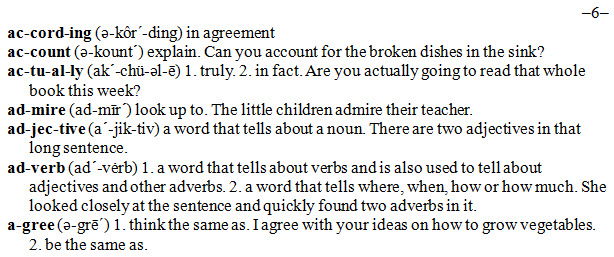
1⠀ac ;ac-cord-9g "<_5-k^%or^.b-d+"> 9 #f
2⠀⠀⠀⠀⠀agree;t
3⠀a3.t ;ac-c.t "<_5-k.t^.b">⠀expla94 ,c y
4⠀⠀⠀⠀⠀a3.t = ! brok5 di%es 9 ! s9k8
5⠀actually ;ac-tu-;al-ly
6⠀⠀⠀⠀⠀"<ak^.b-*^3u-_5l-@-e">
7⠀⠀⠀#a4 truly
8⠀⠀⠀#b4 9 fact4 ,>e y actually go+ to r1d
9⠀⠀⠀⠀⠀t :ole book ? week8
10 admire ad-mire "<ad-m@-ir^.b"> look up
11 ⠀⠀⠀⠀to4 ,! ll *n admire _! t1*]4
12 adjective ad-jec-tive "<a^.b-jik-tiv"> a
13 ⠀⠀⠀⠀^w t tells ab a n\n4 ,"! >e two
14 ⠀⠀⠀⠀adjectives 9 t l;g s5t;e4
15 adv]b ad-v]b "<ad^.b-v^_1erb">
16 ⠀⠀#a4 a ^w t tells ab v]bs & is al us$
17 ⠀⠀⠀⠀to tell ab adjectives & o!r adv]bs4
18 ⠀⠀#b4 a ^w t tells ":1 :51 h[ or h[ m*4
19 ⠀⠀⠀⠀,%e look$ closely at ! s5t;e & qkly
20 ⠀⠀⠀⠀f.d two adv]bs 9 x4
21 agree a-gree "<_5-gr@-e^.b">
22 ⠀⠀#a4 ?9k ! same z4 ,i agree ) yr id1s
23 ⠀⠀⠀⠀on h[ to gr[ vegetables4
24 ⠀⠀#b4 2 ! same z4
25 ⠀⠀⠀⠀⠀⠀⠀⠀⠀⠀⠀⠀⠀⠀⠀⠀ac,-agree #,

3⠀anomie_/desmandado⠀⠀;n4 condici+n social
4⠀⠀⠀en la cual las normas son d!biles1
5⠀⠀⠀conflictivas o ausentes
6⠀444
23 appreh5.n_/aprensi+n⠀⠀;s4 temor de lo
24 ⠀⠀que pueda pasar2 ansiedad
25 ⠀⠀⠀⠀⠀⠀⠀⠀⠀⠀⠀anomie,-appreh5.n #,-

1⠀⠀⠀⠀⠀⠀⠀⠀⠀⠀⠀⠀⠀⠀⠀⠀⠀⠀⠀;,f
2⠀factors⠀"<;p4 #aj">⠀,two or m numb]s t
3⠀⠀⠀⠀⠀>e multipli$ tgr to =m a product4
4⠀⠀⠀factores⠀,dos o m(s n)meros que se
5⠀⠀⠀⠀⠀multiplicand entre s/ para formar un
6⠀⠀⠀⠀⠀producto4

1⠀⠀⠀⠀⠀⠀⠀⠀⠀⠀⠀⠀⠀⠀⠀⠀⠀⠀⠀⠀,a
2⠀absorp;n⠀,! process by : nutri5ts pass
3⠀⠀⠀⠀⠀"? ! l9+ ( ! dige/ive sy/em4
4⠀⠀⠀absorci+n⠀,proceso mediante el cual
5⠀⠀⠀⠀⠀los nutrientes pasan a trav!s de las
6⠀⠀⠀⠀⠀paredes del sistema digestivo4
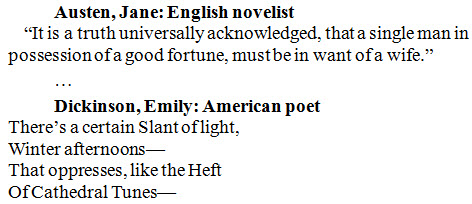
1⠀⠀⠀⠀⠀,au/51 ,jane3 ,5gli% noveli/ #,-
2⠀⠀⠀8,x is a tru? univ]sally ac"kl$g$1 t a
3⠀s+le man 9 posses.n ( a gd =tune1 m/ 2 9
4⠀want ( a wife40
5⠀⠀⠀⠀⠀⠀⠀⠀⠀⠀⠀⠀⠀⠀⠀⠀⠀⠀⠀⠀⠀⠀⠀⠀⠀⠀⠀⠀⠀⠀⠀⠀⠀⠀⠀⠀⠀⠀⠀⠀⠀
6⠀⠀⠀⠀⠀444
7⠀⠀⠀⠀⠀⠀⠀⠀⠀⠀⠀⠀⠀⠀⠀⠀⠀⠀⠀⠀⠀⠀⠀⠀⠀⠀⠀⠀⠀⠀⠀⠀⠀⠀⠀⠀⠀⠀⠀⠀⠀
8⠀⠀⠀⠀⠀,dick9son1 ,emily3 ,am]ican poet
9⠀,"!'s a c]ta9 ,slant ( li<t1
10 ,w9t] afns,-
11 ,t oppresses1 l ! ,heft
12 ,( ,ca!dral ,tunes,-
13 ⠀⠀⠀⠀⠀⠀⠀⠀⠀⠀⠀⠀,au/5,-,dick9son #ae
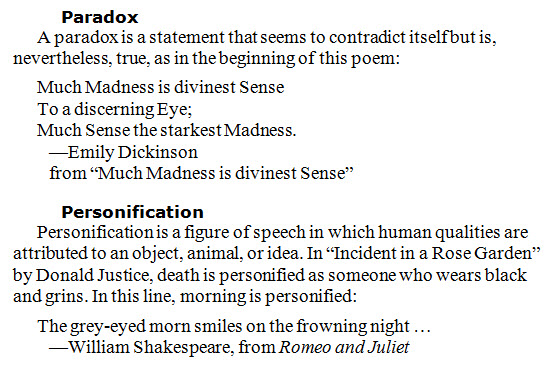
1⠀⠀⠀⠀⠀,p>adox a#ghh
2⠀⠀⠀,a p>adox is a /ate;t t seems to
3⠀3tradict xf b is1 n"e!.s1 true1 z 9 !
4⠀2g9n+ ( ? poem3
5⠀⠀⠀⠀⠀⠀⠀⠀⠀⠀⠀⠀⠀⠀⠀⠀⠀⠀⠀⠀⠀⠀⠀⠀⠀⠀⠀⠀⠀⠀⠀⠀⠀⠀⠀⠀⠀⠀⠀⠀⠀
6⠀⠀⠀,m* ,mad;s is div9e/ ,s5se
7⠀⠀⠀,to a 4c]n+ ,eye2
8⠀⠀⠀,m* ,s5se ! />ke/ ,mad;s4
9⠀⠀⠀⠀⠀⠀⠀,-,emily ,dick9son
10 ⠀⠀⠀⠀⠀⠀f 8,m* ,mad;s is div9e/ ,s5se0
11 ⠀⠀⠀⠀⠀⠀⠀⠀⠀⠀⠀⠀⠀⠀⠀⠀⠀⠀⠀⠀⠀⠀⠀⠀⠀⠀⠀⠀⠀⠀⠀⠀⠀⠀⠀⠀⠀⠀⠀⠀
12 ⠀⠀⠀⠀,p]sonifica;n
13 ⠀⠀,p]sonifica;n is a figure ( spee* 9 :
14 human qualities >e attribut$ to an
15 object1 animal1 or idea4 ,9 8,9cid5t 9 a
16 ,rose ,g>d50 by ,donald ,ju/ice1 d1? is
17 p]sonifi$ z "s"o :o we>s black & gr9s4
18 ,9 ? l9e1 morn+ is p]sonifi$3
19 ⠀⠀⠀⠀⠀⠀⠀⠀⠀⠀⠀⠀⠀⠀⠀⠀⠀⠀⠀⠀⠀⠀⠀⠀⠀⠀⠀⠀⠀⠀⠀⠀⠀⠀⠀⠀⠀⠀⠀⠀
20 ⠀⠀,! grey-ey$ morn smiles on ! fr[n+
21 ⠀⠀⠀⠀ni<t 444
22 ⠀⠀⠀⠀⠀⠀⠀⠀,-,william ,%akespe>e1 f
23 ⠀⠀⠀⠀⠀⠀⠀⠀.7,romeo & ,juliet.'
24 ⠀⠀⠀⠀⠀⠀⠀⠀⠀⠀⠀⠀⠀⠀⠀⠀⠀⠀⠀⠀⠀⠀⠀⠀⠀⠀⠀⠀⠀⠀⠀⠀⠀⠀⠀⠀⠀⠀⠀⠀
25 ⠀⠀⠀⠀⠀⠀⠀⠀⠀,p>adox,-,p]sonifica;n #,-

10 agree⠀⠀;v4 co9cide1 get al;g1 side )1
11 ⠀⠀h>monize )1 mat* up1 3cur1 /& tgr1 g
12 ⠀⠀al;g )1 say yes to1 3=m⠀,-,ant4 di6]1
13 ⠀⠀4agree1 debate4
14 al>m⠀⠀;n4 anxiety1 appreh5.n1 4may1
15 ⠀⠀4tress1 dr1d1 /ra91 /ress1 t5.n
16 ⠀⠀,-,ant4 assur.e1 composure1 p1ce1
17 ⠀⠀repose1 secur;y4
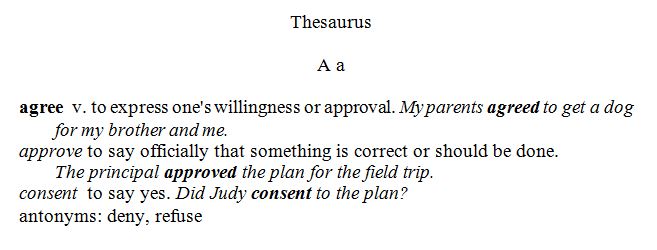
1⠀⠀⠀⠀⠀⠀⠀⠀⠀⠀⠀⠀⠀⠀⠀⠀⠀,!saurus
2⠀⠀⠀⠀⠀⠀⠀⠀⠀⠀⠀⠀⠀⠀⠀⠀⠀⠀⠀⠀⠀⠀⠀⠀⠀⠀⠀⠀⠀⠀⠀⠀⠀⠀⠀⠀⠀⠀⠀⠀⠀
3⠀⠀⠀⠀⠀⠀⠀⠀⠀⠀⠀⠀⠀⠀⠀⠀⠀⠀⠀,a a
4⠀agree⠀⠀;v4 to express "o's will+;s or
5⠀⠀⠀⠀⠀approval4 .7,my p>5ts ^1agre$ to get
6⠀⠀⠀⠀⠀a dog = my bro!r & me4.'
7⠀⠀⠀approve⠀⠀to say (ficially t "s?+ is
8⠀⠀⠀⠀⠀correct or %d 2 d"o4 .7,! pr9cipal
9⠀⠀⠀⠀⠀^1approv$ ! plan = ! field trip4.'
10 ⠀⠀3s5t⠀⠀to say yes4 .7,did ,judy ^13s5t
11 ⠀⠀⠀⠀to ! plan8.'
12 ⠀⠀antonyms3 d5y1 refuse

5⠀fumble fum_4ble _/f^/umb_5l_/ ;v4 @& ;n4
6⠀⠀⠀;v4
7⠀⠀⠀⠀⠀#a .19tr4 "<(t5 foll4 by .7at1 )1 =1
8⠀⠀⠀⠀⠀⠀⠀⠀⠀af.'"> use ! h&s awkw>dly2 grope
9⠀⠀⠀⠀⠀⠀⠀⠀⠀ab4
10 ⠀⠀⠀⠀#b .1tr4
11 ⠀⠀⠀⠀⠀⠀a h&le clumsily or n]v\sly4
12 ⠀⠀⠀⠀⠀⠀;b .1,football drop "<! ball">4
13 ⠀⠀;n4 an act ( fumbl+4
14 ⠀⠀,-^1fumbl] ^1fum_4bl] ;n4
15 ⠀⠀⠀⠀⠀⠀⠀⠀^1fumbl+ly ^1fum_4bl+_4ly adv4